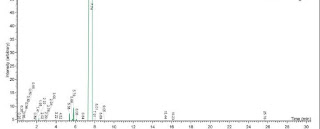Was looking for something else in my archives and came across this, from a chemist in Connecticut whose real name always remained a mystery. He was an online friend who knew a LOT about Essential Oil chemistry, and delighted in teaching it.
The topic of the message was "pretty smelling mystery oil" so it would appear I had been talking about something that I couldn't identify... and the subject of analysis came up. this was his explanation of "how it works":
From: DrPriszm@aol.comDate: Sun, 13 Oct 1996 01:29:59 -0400
Well, not really, but you're close! Get ready for the $1.39 course on
gas
chromatography! (But only if you promise to attend my real class in
person!)
A gas chromatograph is really like an oven. Inside the oven is a
hollow tube which is coiled round and round like a garden hose so it will fit in
the oven, because it may be 25 meters long. Inside the tube is something
similar to sand, very fine sand. There is some type of gas always flowing
through the tube, from one end to the other.
On the front end of the tube, where
the gas is coming from, is an injection port. It is through this port that
the sample is injected onto the column, or tube. The flowing gas carries
the sample through the column. As the sample travels through the column,
the
various components of the sample separate, and form bands in the
column.
Picture a marching band shoulder to shoulder marching down a street,
and then gradually they start separating until they are 10 feet apart of
each other. Now they're marching single file, but they're separated by that
10 feet? O.K. so far? Good.
Now at the end of the column, there is a
detector. There are many types of detectors, but it really doesn't matter. As
each component marches past the detector on its way out of the column, the detector produces an electrical signal. If the component is present in
a high concentration, the detector produces a big signal. If the component
is only present in a small concentration, the detector produces a small
signal.
The signal then goes to a strip chart recorder. You know what that
is? Picture the device that the old fashioned lie detectors used to use.
You know, the pen would move on the paper and produce a wiggly line? Same
thing. The strip chart recorder draws peaks when the detector "sees" a
component. Big peak for high concentrations, small peaks for small concentrations.
 | |||||
| This is the printout of a very simple oil with one major component | . |
Here comes the math, be brave. Simultaneously when
the detector sends its signal to the strip chart recorder, it sends an
identical signal to a computer processor. The computer automatically computes the
area under the peak of each component, and compares it to the area of the peak
of a standard. Then, by a simple proportion, it calculates the concentration
of the unknown peak to the concentration of a standard compound whose
concentration we do know.
Let me give you an example. I take a
known amount, say one gram of eucalyptol, the major component of eucalyptus
oil, and inject it into my G.C. (gas chromatograph). I get a peak, and that
peak is always the same height as long as I inject one gram of eucalyptol into
the G.C. If I inject 1/2 gram of eucalytol, I get a peak 1/2 the height, and
so on. So I tell the computer that when you see a peak that is exactly the
same height as my one gram standard, report that one gram of eucalyptol is in
my sample. Now the peaks are not all on top of each other, because you
couldn't tell them apart. They are separated on the paper just as the components
are separated on the column. The first peak to appear corresponds to the
first peak that comes through the column.
Your chromatogram of essential oils
may contain hundreds, or even thousands of peaks! How then, do we identify
which peaks correspond to which components? Well, we have to inject hundreds
or thousands of standards of known components into the G.C. We then note
the time it takes, from injection, until the compound hits the detector
in
minutes.
We call this the elution time, or the time it takes for a compound to
elute from the column. Each compound has a unique elution time, and can be identified this way. Now, let me tell you that it is WAY more
complicated than that, and I could go into the various types of columns,
injectors,detectors, gases, etc., but that is the gist of it.
I had one supplier who would send a gc upon request... with the major peaks marked by hand. Their equipment was not hooked up to a machine... he identified the peaks by hand. Also, the detail (and accuracy) an analyst can give is determined to a great part by the depth/breadth of the "Library" of analyses they have access to.
I'm hoping this description makes a little bit of sense! (Yes, it's simplistic. There may be those who will scoff at the analogy of the marching band. Feel free to scoff.)



No comments:
Post a Comment